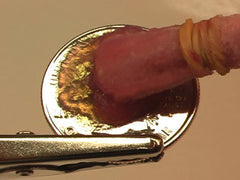How does gold plate onto the surface?
The gold plating solution we used to plate the quarter is loaded with an enormous number of gold ions. These gold ions are gold atoms missing one or more electrons, they are formed when metallic gold has been dissolved in a solution (the gold is oxidized). While in solution these gold ions are invisible - that is why our 24K Pure Gold Solution is water clear. In fact the gold ions remain invisible until they come into contact with the surface that has been charged with excess electrons - the cathode - which is the surface being plated. With the proper voltage potential (the voltage difference between the charged solution and the surface being plated - usually 2-5 volts), when the gold ions contact the cathode there is a virtually instantaneous "cathode reaction" and the gold ions recover the missing electron(s), (reduction), and the gold returns to it's metallic state, usually in a cubic crystalline structure. The brightening system in our 24K Brush Gold Solution disrupts the crystal growth resulting in a large number of very fine grained crystals. This fine grained crystal structure results in a much harder, brighter gold deposit.

The lavender color of the 24K Brush Gold solution is caused by the gold brighteners used to produce a shiny, hard 24 karat gold plate.
Gold plating is really thin!
In fact: A sheet of 20 lb. copy paper is 200 to 300 times thicker than the gold in normal decorative gold plating.
So just what does 3.3 mg of gold applied to the quarter really mean?
For the surface area of one side of a quarter it means that the average gold thickness is about 0.000015" or 15 millionths of an inch; that is very thin compared to paint or other types of coatings. In fact, if you cut the quarter we plated in the video in half and measured the cross section with a microscope you would see that the quarter is ~ 4600 times thicker than the gold plating. If you scaled up the view so that the gold plating appeared to be the same thickness as a sheet of 20 lb copy paper (3.8 mils), the quarter would appear to be more than 17 inches thick!
Fortunately, one of the properties of gold is that it will function as a useful coating even when it is extremely thin, so 15 millionths of an inch is average for a normal decorative gold plate. It is still hard to think of the thickness of gold plating in everyday terms so we have come up with some other interesting facts.
How many gold atoms are on the gold plated quarter?
The number of gold atoms plated onto this quarter is a big number. There are about ten billion billion (1 x 10 to the 19th) atoms in 3.3 milligrams of gold.
Using a popcorn analogy, if each of the atoms of gold deposited on the quarter (3.3 milligrams gold) was magically changed into an un-popped kernel of popcorn, we would have an abundant popcorn supply. In fact, there would be enough popcorn kernels to cover the entire lower 48 United States with a layer more than eight inches thick!
